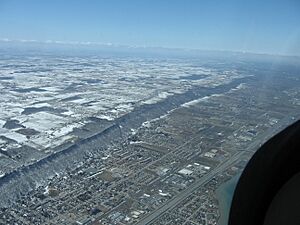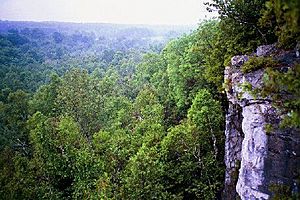Niagara Escarpment facts for kids
The Niagara Escarpment is a very long cliff or ridge of rock that stretches across parts of the United States and Canada. It runs mostly from east to west, starting in New York and going through Ontario, Michigan, Wisconsin, and Illinois. This amazing natural feature is most famous because the Niagara River plunges over it to create Niagara Falls, which is how it got its name!
The Niagara Escarpment is a special place. UNESCO has named it a World Biosphere Reserve. This means it's recognized globally for its unique natural environment. It's home to some of the oldest forest ecosystems and trees in eastern North America.
This long ridge is made of a type of rock called dolostone. This rock formed millions of years ago. The Escarpment is the biggest of several similar rock ridges found in the Great Lakes Basin. It helps shape the land around Lake Ontario, Lake Huron, and Lake Michigan.
For example, in Rochester, New York, the Genesee River flows over the Escarpment, creating three beautiful waterfalls. The Escarpment then continues west to the Niagara River, forming the deep gorge where Niagara Falls is located. In southern Ontario, it goes through cities like St. Catharines, Hamilton, and Milton. It then turns north towards Georgian Bay, forming the backbone of the Bruce Peninsula and Manitoulin Island. From there, it goes into the Upper Peninsula and then south into Wisconsin, ending near the border of Wisconsin and Illinois.
Contents
How the Escarpment Formed

The Niagara Escarpment wasn't formed by a fault line (where the Earth's crust breaks). Instead, it was created over millions of years by something called erosion. Think of it like this: the top layer of the Escarpment is made of a hard rock called dolostone. Below this hard rock are softer rocks, like shale, that wear away more easily.
Over a very long time, rain, wind, and rivers slowly wore away the softer rocks underneath. This made the harder dolostone layer stick out like a cliff. This process is easiest to see at Niagara Falls, where the powerful river has carved out the gorge. You can also see it at the waterfalls of the Genesee River in Rochester, New York. Sometimes, thick layers of glacial till (stuff left behind by glaciers) can hide parts of the Escarpment.
The dolostone at the top of the Escarpment was formed from sediments at the bottom of an ancient tropical sea. Tiny shells and bits of calcium carbonate settled there. Over time, these layers hardened into limestone and then into the tougher dolostone. When the sea eventually retreated, erosion began to shape the land, leaving behind this impressive Escarpment.
People and the Escarpment
The Niagara Escarpment has played a big role in how people live and travel in the region.
Canals and Transportation
The Welland Canal in Ontario helps ships get around the Escarpment between Lake Erie and Lake Ontario. In New York, the Escarpment was a major challenge for building the Erie Canal. A series of locks were built to help boats climb and descend the cliff. The town that grew up there is even called Lockport, New York.
Trails and Cities
In southern Ontario, the famous Bruce Trail follows the entire length of the Escarpment. It goes from Queenston on the Niagara River all the way to Tobermory on the Bruce Peninsula. Highway 401, one of Canada's busiest roads, also crosses the Escarpment.
The city of Hamilton, Ontario is built right on the Escarpment. The northern part of the city is below the cliff, and the southern part is on top. Locals often call the Escarpment "The Mountain." Many roads connect the lower city with the upper parts.
Parks and Recreation
High Cliff State Park in Wisconsin shows how people have used the Escarpment for a long time. You can find ancient effigy mounds (earthworks shaped like animals) and the remains of an old limestone quarry there.
The Escarpment's exposed cliffs are also used for wind farms in Wisconsin, where the wind is strong. Many resorts and ski areas in Ontario, Michigan, Wisconsin, and New York are located along the Escarpment, making it a popular spot for winter sports.
Vineyards and Wine
The Niagara Escarpment's unique landscape and climate make it perfect for growing grapes for wine!
New York Vineyards
In Niagara County, New York, there's a large area called the Niagara Escarpment AVA (American Viticultural Area). Here, vineyards grow grapes like Merlot, Chardonnay, and Riesling. They also make delicious fruit wines.
Ontario's Wine Country
Ontario's Niagara Peninsula is Canada's largest wine-producing region. Cool-climate grapes like Riesling, Chardonnay, and Pinot Noir thrive here. Three special wine-growing areas are located along the slopes of the Niagara Escarpment: Short Hills Bench, Twenty Mile Bench, and Beamsville Bench.
Wisconsin's Wine Region
Northeastern Wisconsin also has a wine region called the Wisconsin Ledge AVA. Most vineyards are on the Escarpment's eastern slope, which faces Lake Michigan. The lake helps keep the air moving, preventing cold air from settling and making the growing season longer. The soil here is a mix of gravel, sand, and clay over limestone, which is great for grapevines.
World Biosphere Reserve
In February 1990, the Niagara Escarpment was officially named a World Biosphere Reserve by UNESCO. This means it's one of only 12 such special places in Canada. The Niagara Escarpment Commission, an agency of the Ontario government, helps manage and protect the land on and around the Escarpment.
The cliffs along the Niagara Escarpment have the oldest forest ecosystem in eastern North America. Some of the trees, like the eastern white cedar, are incredibly old. The oldest known tree in Ontario dates back to 688 A.D.! In Wisconsin, a 1,300-year-old eastern white cedar was found in Brown County. These ancient trees are a testament to the Escarpment's long and rich natural history.
Images for kids
-
The Niagara River over thousands of years carves the Niagara Gorge over and through the Niagara Escarpment







